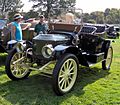Stanley Motor Carriage Company facts for kids
The Stanley Motor Carriage Company made special cars powered by steam. These cars were called Stanley Steamers. The company started in 1898 in the United States. They made cars from 1896 to 1924.
In the early 1900s, steam was a common power source. It powered trains, boats, and even sewing machines. So, it made sense to try using steam for cars too. Among all the steam cars of that time, the Stanley Steamer was the most famous. Today, Stanley Steamers are very rare. You can mostly find them in museums or special car collections.
Contents
Who Invented the Stanley Steamer?
The Stanley Steamer was invented by twin brothers, Francis E. Stanley and Freelan O. Stanley. Freelan was a teacher and a high school principal. Francis was also a teacher but later became a photographer.
In 1885, both brothers left their teaching jobs. They started a company that made photographic plates. These plates were used by photographers. They sold this business and moved to Watertown, Massachusetts. There, they started another photographic plate company. They sold this second company to Eastman Kodak in 1904. The brothers were now very interested in making cars. They wanted to focus on that full-time.
How Stanley Steamers Were Built
Many inventors were trying to build cars during this period. The Stanley brothers first built two cars just for fun. In 1898, they showed their cars at the first car show in the U.S. This event was held in Boston. Cars from both the U.S. and Europe were on display.
There was also an outdoor competition. The Stanley Steamers were much faster than other cars. They could also climb hills better. No gasoline car could climb a 15% slope. A Whitney steam car almost climbed a 20% slope. But the Stanley Steamer easily climbed a 30% slope.
With the money from selling their company to Eastman Kodak, they started making steam cars. In 1899, they made and sold over 200 cars. This was more than any other U.S. car maker that year.
Climbing Mount Washington
In 1899, Freelan Stanley and his wife, Flora, drove a Stanley Steamer to the top of Mount Washington. This mountain is in New Hampshire and is the highest peak in the northeastern United States. The climb took more than two hours. It was a big deal because it was the first time a car had ever climbed the 7.6-mile-long Mount Washington Carriage Road. They drove down by putting the engine in a low gear and using the car's brakes.
The twins later sold the rights to this early car design to another company called Locomobile. In 1902, they officially formed the Stanley Motor Carriage Company.
The End of Steam Cars
Stanley allowed other car companies to use their designs. The White Motor Company was one of them. They made steam cars until 1912. Stanley was the very last company to make steam-powered cars.
Over time, gasoline engines got much better. Because of this, steam cars and electric cars became less popular. The number of Stanley Steamers sold dropped to less than 600 a year by 1918. That year, the Stanley brothers sold their company to Prescott Warren. He was a businessman from Chicago.
Francis Stanley died in a car accident later in 1918. His brother, Freelan, opened a hotel in Colorado called The Stanley Hotel. He lived to be 91 years old. Stanley Steamers continued to be made until 1924.
How a Stanley Steamer Worked
Early Stanley cars had bodies made of wood. These bodies were attached to steel frames with leaf springs. Later, car bodies were made from aluminum.
A special burner, which used kerosene, heated a drum-shaped boiler. This boiler stored steam. The driver controlled the steam going to the engine using a throttle. There was no need for a transmission (gears).
Starting a Stanley Steamer in the morning was quite noisy. It sounded like a steam train, with lots of hissing and chugging. It was also very hard to steal a Stanley Steamer. It took about 20 minutes to build up enough steam before the car could even move.
Once it was moving, the car seemed to have endless power. An early Stanley Steamer could go up to 75 miles per hour. In 1906, a Stanley Steamer set a new land speed record. It reached 127 miles per hour in Florida.
To drive a Stanley Steamer, the driver had to watch many gauges. There were 13 handles, pumps, and valves to adjust. The cars carried only a small amount of water because water is heavy. This meant the car could only go about 40 miles before needing more water. The kerosene burner was also known to cause fires.
Gasoline-powered cars with internal combustion engines were much easier to operate. This made steam cars outdated and less useful.
Related pages
Images for kids
-
F. O. Stanley and his wife Flora drove to the top of Mount Washington in New Hampshire to generate publicity for their firm.
-
A 1908 Stanley leaving the starting line at the Newport Antique Auto Hill Climb
See also
 In Spanish: Stanley (automóviles) para niños
In Spanish: Stanley (automóviles) para niños
















